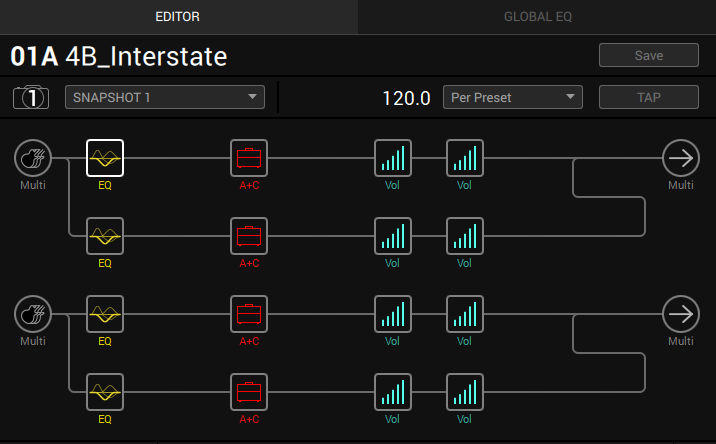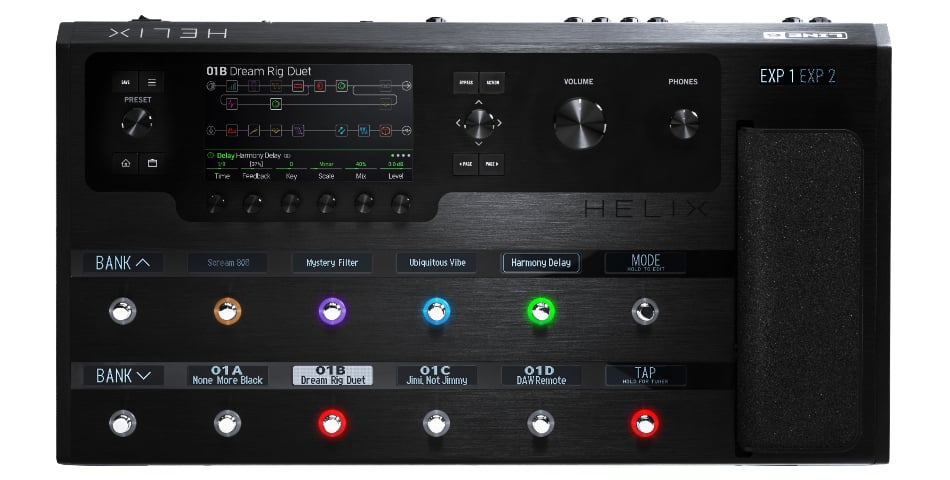by Craig Anderton
If you’ve heard the Line 6 Helix in action, you might wonder how it would be possible to get even better sounds than the amp Definition:
Definition:
Abbreviation for either Ampere or Amplifier. and cabinets that are already included. However, there is a way—thanks to the Helix’s ability to split the guitar into four parallel signal paths.
The technique we’ll cover is multiband distortion Definition:
Definition:
A change in an electronic or acoustic signal's waveform. This can undesirable if it impacts signal quality, or desirable when used for creative signal processing., where you create four different frequency Definition:
Definition:
A value, expressed in Hertz, that indicates how many cycles of a periodic signal occur in one second. bands (low, low mid, high mid and high), distort each one individually, and then mix the four bands back together again. Because each amp needs to deal with only a limited frequency range, for rhythm guitar and power chords the sound is bigger, has more articulation, and is much more “focused.”
How to Create a Multiband Setup
Referring to Figure 1, start with a new preset Definition:
Definition:
1. (verb) Ability to set parameters in advance, and recall those parameter values as desired. 2. (noun) A collection of parameter values stored within a device, or externally.. Set both signal paths to the same input, then drag a block downward from each signal path to create a second, parallel line for their respective paths. This creates four parallel signal paths.
 Figure 1: This multiband distortion template for the Line 6 Helix splits the guitar into four bands, and then distorts each one individually for a big, rich, focused sound.
Figure 1: This multiband distortion template for the Line 6 Helix splits the guitar into four bands, and then distorts each one individually for a big, rich, focused sound.
Insert a 10-band graphic EQ block into each path. The low frequency band turns the 62.5, 125, and 250 Definition:
Definition:
Stereo Sound with 2 speakers and no subwoofer. See subwoofer. Hz Definition:
Definition:
See Hertz. bands up full, and sets 500 Hz at around -10 dB Definition:
Definition:
1. A deciBel is a logarithmic ratio between two quantities, and is a nonlinear measurement that mimics human perception. 2. A unit expressing sound levels relative to a nominal level just audible by the average human ear, and equal to 1/10th of a Bel.. The next higher band turns the 250 and 500 Hz bands up full, with 1 kHz Definition:
Definition:
kHz (Kilohertz): 1,000 Hertz, or one thousand cycles per second. down about -4 dB. The next band has 500 Hz down about -8.5 dB, and 1 and 2 kHz up all the way. The highest band has 2, 4, 8, and 16 kHz up full, with 1 kHz at about -8 dB. The bands overlap somewhat because that’s what sounded best with my guitar, but where to split the bands varies with your guitar of choice, its pickups, and the purpose of the preset.
Now insert four Amp+Cabs. I tend to use the same Amp+Cab in each of the four paths, but the possibilities are endless—like a Marshall-type sound for the low frequencies, and a chimey Vox sound for the higher frequencies. However, since the signal is being split up four ways each amp is getting less signal, so you’ll need to turn up the Drive to compensate. You’ll probably need to turn down the Master too, because the output from four amps adds up. (Also note that turning down Drive for the highest-frequency path can give a sweet, less harsh sound, and that pulling down all the Drives somewhat can produce some beautiful clean tones.)
Tweaking the Preset
The Gain blocks in Figure 1 make tweaking easier. I set them all to zero gain, so that enabling the Gain block mutes the sound. Bypassing a Gain block allows tweaking a particular path without hearing the others. After creating your preset, you can delete these. The last block is for Pan Definition:
Definition:
Horizontal pivot of a camera or light, opposite of Tilt, or the placement of a sound element in stereo or surround sound. . I usually leave the high and low bands centered, and spread the middle bands a bit to give a stereo Definition:
Definition:
A two channel signal simulating a sound space, typically played through two speakers. image.
Finally, amps and cabs take a lot of processing power, so multiband distortion uses up a lot of the Helix’s power. You should still be able to add at least some effects, and this is where it gets really interesting—for example, insert chorus, delay, or auto filter in only the middle two bands.
But the proof is in the playing: create a preset with only one Amp+Cab, then create a multiband preset using the same Amp+Cab... and prepare to be amazed when you compare the two.



